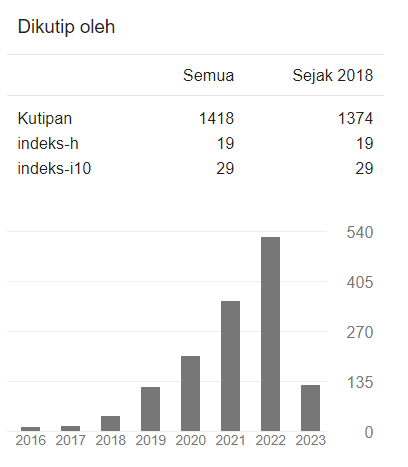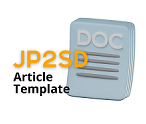Pengembangan Multimedia Interaktif Materi Cuaca untuk Kelas 3 Sekolah Dasar
DOI:
https://doi.org/10.22219/jp2sd.v11i2.26413Keywords:
Multimedia Interaktif, Cuaca, Sekolah DasarAbstract
Technology provides changes in the application of student learning, which initially could only listen to explanations from teachers and understand material that only comes from textbooks. Still, with current technological developments, the information obtained is sourced from student books and interactive media. This research aims to produce interactive multimedia weather material for class 3 SDN Bareng 2 Malang and to analyze the validity, attractiveness, and effectiveness of class 3 SDN Bareng 2 Malang. This development research uses the ADDIE model to measure validity, effectiveness, and attractiveness later—interactive multimedia on whether the material was developed for grade 3 at the elementary school level. The results of the validity of multimedia obtained from material experts amounted to 93.75% and entered the criteria for a very valid eligibility level. Meanwhile, media experts are 88.3% in the very valid category. Then, the results of linguists are 90% and reach the criteria of very valid or appropriate to be used as learning media and can be tested in the field. Then, the results of the attractiveness of multimedia obtained 98.9% with desirable criteria. The effectiveness of getting a score from the pre-test in individual trials reached a score of 140. In the post-test, it achieved a score of 250. Furthermore, small group trials achieved 870 in the pre-test results. Then, the post-test results rose to 1350. The final test was the field trial to 2365, and then the post-test score increased to 3965. In conclusion, the pre-test and post-test scores increased from 62 students in grade 3 at SDN Bareng 2, which was 54.43% in the pre-test then 89.75% in the post-test.
Downloads
References
Agustina, A. (2016). Pembelajaran Konsep Ikatan Kimia dengan Animasi Terintegrasi LCD Projector Layar Sentuh (Low Cost Multi Touch White Board). Jurnal Tadris Kimiya. 1(1), 8-13 . http://www.journal.uinsgd.ac.id/index.php/tadris-kimiya/article/view/1163, diakses 20 Juli 2023.
Alba, A. P., & Akbar, S. (2019). Bahan Ajar Tema Daerah Tempat Tinggalku Berbasis Kearifan Lokal. Jurnal Pendidikan : Teori, Penelitian, Dan Pengembangan, 4(4), 421–426.
Armansyah, Firdausy., Sulthon., Sulthoni. (2019). Multimedia Interaktif Sebagai Media Visualisasi Dasar-Dasar Animasi. Jurnal Kajian teknologi Pendidikan. 2(3), 224-229. http://journal2.um.ac.id/index.php/jktp/article/view/8283/4366, diakses 20 Agustus 2023.
Arikunto. (2019). Prosedur Penelitian. Jakarta. Rineka Cipta.
Astutik, Kristin Puji, Tyas Deviana, Bustanol Arifin. (2021). Pengembangan Media Interaktif Chesee (Cheerful House of Children)untuk Pembelajaran Tematik Tema Permainan TradisionalPada Kelas III SD. Jurnal Pemikiran dan Pengembangan Sekolah Dasar. 9(1), 94-102. (online) https://ejournal.umm.ac.id/index.php/jp2sd/article/view/18503/12178, diakses 20 Juli 2023.
Atmaja, I. M. D. (2020). Membangun Toleransi Melalui Pendidikan Multikultural. Jurnal Pendidikan Kewarganegaraan Undiskha, 8(1), 113–121. (online) https://ejournal.undiksha.ac.id/index.php/JJPP%0AMEMBANGUN, diakses 8 agustus 2022.
Baihaqi, M. R., W.S., R., & Dindin Abdul Muiz Lidinillah. (2018). Pengembangan Media Kartu Nusantara untuk Pembelajaran IPS Kelas IV N pada Materi Keanekaragaman Suku Bangsa dan Budaya. Jurnal Ilmiah Pendidikan Guru Sekolah Dasar, 5(2), 47–58.
Fitriani, I., Fitriyah, C. Z., & Hutama, F. S. (2019). Pengembangan Media Pembelajaran “Monopoli Keberagaman” Tema Indahnya Keragaman di Negeriku untuk Peserta Didik Kelas IV. Jurnal Profesi Keguruan, 5(1), 76–82.
Hsiao, C. C., Tiao, M. M., & Chen, C. C. (2016). Using interactive multimedia e-Books for learning blood cell morphology in pediatric hematology. BMC Medical Education, 16(1), 1–8. (Online). https://doi.org/10.1186/s12909-016-0816-9, diakses 5 Juni 2022.
Helpiyotwitra. (2019). Upaya Untuk Meningkatkan Hasil Belajar Ips Dengan Menggunakan Media Video Pada Siswa Kelas Vi n 004 Teratak Buluh. Jurnal PAJAR (Pendidikan Dan Pengajaran), 3(4), 808–818.
Hilmi, M. Z. (2017). Implementasi Pendidikan Ips Dalam Pembelajaran IPS di Sekolah. Jurnal Ilmiah Mandala Education, 3(2), 164–172.
Hendikawati, P., Zahid, M. Z., & Arifudin, R. (2019). Android-Based Computer Assisted Instruction Development as a Learning Resource for Supporting Self-Regulated Learning. International Journal of Instruction, 12(3), 389–404.
Izzatillah, N. (2017). PEMBELAJARAN SEJARAH LOKAL SITUS CANDI HINDU BUDHA DI PASURUAN BERBASIS MULTIMEDIA INTERAKTIF Nuri Izzatillah. 1(12), 73–79.
Komalasari, M. D., & Wihaskoro, A. M. (2018). Multimedia Interaktif Bermuatan Keanekaragaman Budaya Indonesia Pada Pembelajaran Tematik Untuk Meningkatkan Rasa Cinta Tanah Air Siswa Sekolah Dasar. Jurnal Elemntary School, 5(1), 130–137.
Kumalasari, M. P. (2018). Kepraktisan Penggunaan Multimedia Interaktif pada Pembelajaran Tematik Kelas IV SD Maharani Putri Kumalasani PGSD Universitas Muhammadiyah Malang Perkembangan Ilmu Pengetahuan dan Teknologi ( IPTEK ) Bergerak Secara Dinamis Seiring dengan Perkembangan Zam. Jurnal Bidang Pendidikan Dasar (JBPD), 2(1), 1–11.
Kuncahyono, K., & Sudarmiatin, S. (2018). Pengembangan Multimedia Interaktif Pada Pembelajaran Tematik Indahnya Negeriku Untuk Siswa Kelas IV Sekolah Dasar. Ilmu Pendidikan: Jurnal Kajian Teori Dan Praktik Kependidikan, 3(2), 156–163. (online). https://doi.org/10.17977/um027v3i22018p156, diakses 20 Juni 2022
Makkih, F. Nasution dan Yerniabdhoko, Y. 2020. Pengembangan Media Setar Berbasos Android pada Pembelajaran IPS Materi Keberagaman Suku dan Budaya di Indonesia pada kelas IV Sekolah Dasar. Jurnal Education and Development. Institusi pendidikan tapanuli Selatan, 8(3), 275-281
Mukmin, B. A., & Primasatya, N. (2020). Pengembangan Multimedia Interaktif Macromedia Flash Berbasis K-13 Sebagai Inovasi Pembelajaran Tematik Untuk Siswa Sekolah Dasar. Jurnal Pendidikan Dasar Nusantara, 5(2), 211–226. (Online). https://doi.org/10.29407/jpdn.v5i2.13854, diakses 10 agustus 2022.
Novaliendry, D. (2013). Symposium presidential influence over administrative action scientific integrity: The perils and promise of white house administration. Jurnal Teknologi Informasi Dan Pendidikan, 6(2), 2086–4981.
Nuanmeesri, S. (2018). The Development of the Virtual Learning Media of the Sacred Object Artwork. The Turkish Online Journal of Educational Technology, 17(1), 197–209.
Permatasari, I. S., Hendracipta, N., & Pamungkas, A. S. (2019). Pengembangan Media Pembelajaran Video Animasi Hands Move Dengan Konteks Lingkungan Pada Mapel Ips. Jurnal Pendidikan Dan Pembelajaran Dasar, 6(1), 34–48.
Prayogi, D. S., Utaya, S., & Sumarmi, S. (2019). Internalisasi Kearifan Lokal Dalam Pembelajaran melalui Pengembangan Multimedia Interaktif Muatan Pembelajaran IPS. Jurnal Pendidikan: Teori, Penelitian, Dan Pengembangan, 4(11), 1457–1463. (Online). http://journal.um.ac.id/index.php/jptpp/article/view/12990, diakses 13 Juni 2022.
Rachmawati, Dwi Novia, Ita Kurnia, Alfi Laila. (2023). Multimedia Interaktif Berbasis Articulate Storyline 3 Sebagai Alternatif Media PembelajaranMateriKarakteristik Geografis Indonesia diSekolah Dasar. Jurnal Pemikiran dan Pengembangan Sekolah Dasar, 11(1), 106-121. (Online), diakses 26 Juli 2023.
Ramadhani, R., & Muhtadi, A. (2018). International Journal of Multicultural and Multireligious Understanding. International Journal of Multicultural and Multireligious Understanding, 5(6), 9–15. (Online) http://dx.doi.org/10.18415/ijmmu.v5i6.488, diakses 26 oktober 2022.
Riyanti, N. N., & Abdullah, M. H. (2018). Penerapan Model Pembelajaran Kooperatif Tipe Make A Match Untuk Meningkatkan Hasil Belajar Ips. Jurnal Pendidikan Guru Sekolah Dasar, 06(04), 440–450.
Suparmini. (2015). Meningkatkan Motivasi Dan Hasil Belajar Ips Keragaman Suku Bangsa Dan Budaya Dengan Permainan Tembar Pada Siswa Kelas 4 A n Semboro 01 Jember. Pancaran, 4(3), 161–170.
Surjono, De. 2017. Multimedia Pembelajaran Interaktif Konsep dan Pengembangan. Yogyakarta: UNYPress.
Trinawindu, I. B. K. (2016). Multimedia Interaktif untuk Proses Pembelajaran. Jurnal Prabangkara. 19 (23), 35-42 . https://jurnal.isi-dps.ac.id/index.php/prabangkara/article/view/135/75, diakses 18 Juli 2023.
Trondle, P., Mandl, H., Fischer, F., & Hartmut, J. (2000). Building University Electronic Educational Environments. Building University Electronic Educational Environments. (Online). https://doi.org/10.1007/978-0-387-35502-3, diakses 8 Juni 2022.
Wahyuningtyas, N., & Ratnawati, N. (2016). Interactive Multimedia as Autonomous Learning Resource in the South Slope of Kelud Mt . In Blitar Regency. Journal of Education and Practice, 7(29), 168–171.
Wiana, W. (2017). Interactive Multimedia-Based Animation : A Study of Effectiveness on Fashion Design Technology Learning Interactive Multimedia-Based Animation : A Study of Effectiveness on Fashion Design Technology Learning. Journal of Physics: Conference Series, 953(012024), 1–8.
Yayuk, Erna., Arina Restian., Nizam Firdaus Ramadhani. (2021). Penggunaan Adobe Flash Cs3 untuk MengembangkanMedia Pembelajaran Berbasis Animated VideoPada Materi TematikKelas ISD. Jurnal Pemikiran dan Pengembangan Dasar. 9(2), 144-157. https://ejournal.umm.ac.id/index.php/jp2sd/article/view/18100. Diakses pada 28 Juli 2023.
Downloads
Published
Issue
Section
License
Copyright (c) 2023 Anggun Citra Putri Ngananti, Imam Agus Basuki, Wida Rahayuningtyas

This work is licensed under a Creative Commons Attribution-ShareAlike 4.0 International License.
Authors who publish with Jurnal Pemikiran dan Pengembangan Sekolah Dasar (JP2SD) agree to the following terms:
- For all articles published in Jurnal Pemikiran dan Pengembangan Sekolah Dasar (JP2SD), copyright is retained by the authors. Authors give permission to the publisher to announce the work with conditions. When the manuscript is accepted for publication, the authors agree to automatic transfer of the publishing right to the publisher.
- Authors retain copyright and grant the journal right of first publication with the work simultaneously licensed under a Creative Commons Attribution-ShareAlike 4.0 International License that allows others to share the work with an acknowledgment of the work's authorship and initial publication in this journal.
- Authors are able to enter into separate, additional contractual arrangements for the non-exclusive distribution of the journal's published version of the work (e.g., post it to an institutional repository or publish it in a book), with an acknowledgment of its initial publication in this journal.
- Authors are permitted and encouraged to post their work online (e.g., in institutional repositories or on their website) prior to and during the submission process, as it can lead to productive exchanges, as well as earlier and greater citation of published work (See The Effect of Open Access).

This work is licensed under a Creative Commons Attribution-ShareAlike 4.0 International License.


















